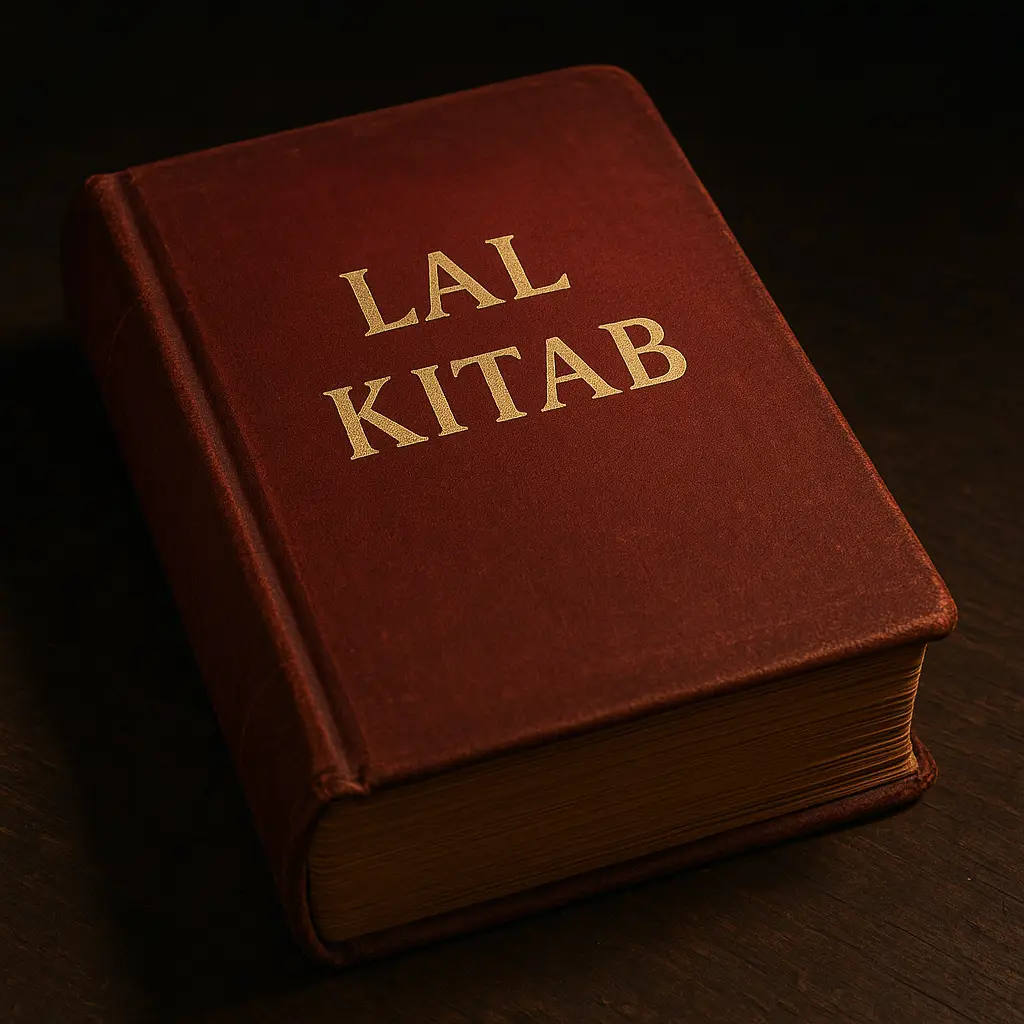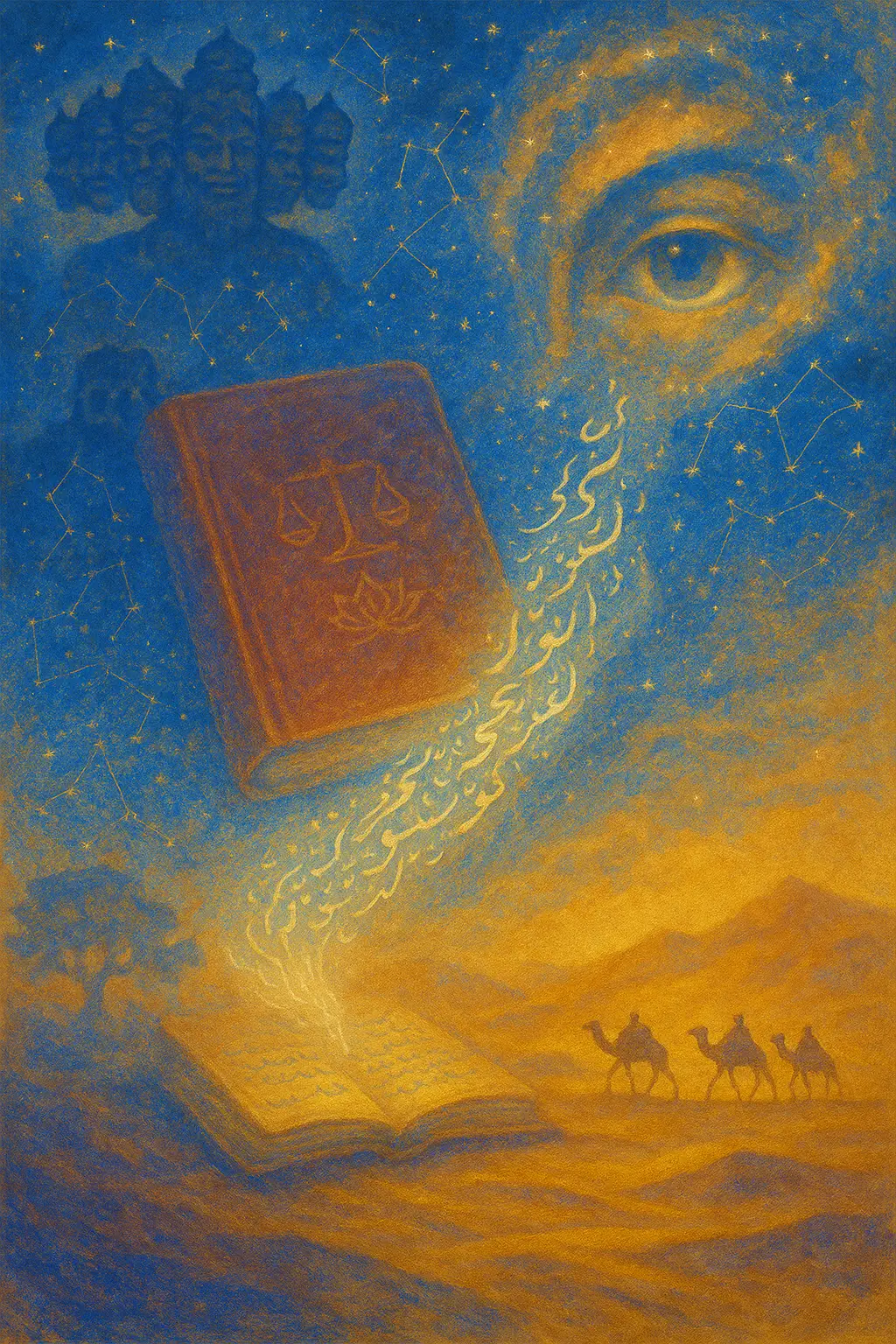The Red Ledger of Karma: Unveiling the Mysterious Origins of Lal Kitab
Indian astrology is a vast landscape, traditionally dominated by ancient Sanskrit texts. But in the 20th century, a mysterious book emerged that broke all the rules. It was written not in the language of priests, but in the everyday Urdu of the common person.
This was the Lal Kitab, the "Red Book" of destiny. It didn't speak of fates sealed by the gods, but of a cosmic balance sheet that anyone could audit and settle.

The enigmatic Lal Kitab, often called the "Red Book," represents a unique system of astrological remedies and karmic accounting.
Often mistaken for a simplified version of Vedic astrology, the Lal Kitab is a complete and revolutionary system in its own right. It's an astrology for the people, forged in the practical world of a government accountant. It reframes our destiny as a duniyavi hisaab kitaab—a worldly ledger of karmic accounts that we can review, remedy, and resolve.
Join us as we explore the genesis of this remarkable system, from its creator's personal struggles to the controversies that still surround this potent Red Book.
The Accountant-Seer: Who Was Pandit Roop Chand Joshi?

A symbolic portrait of Pandit Roop Chand Joshi, who bridged the worlds of meticulous accounting and intuitive astrology to create the Lal Kitab system.
The soul of the Lal Kitab is inseparable from its author, Pandit Roop Chand Joshi.
Born in 1898 in Punjab, his path was unconventional. He didn't come from a priestly lineage. Instead, his father was a revenue official, and he built a career in the Defence Accounts Department of the British Indian government.
This life as an accountant profoundly shaped his spiritual vision. He saw the universe through the lens of a ledger, where karma was a series of debits and credits. Even the name Lal Kitab is inspired by the red ledger books used by Indian merchants.
His journey into the occult was intuitive and self-taught, starting with an uncanny ability to read a person's fortune by observing their cattle. This evolved into an expertise in palmistry. The turning point came in a dream, where a divine being tasked him with revealing this new system to the world.
The Lal Kitab reimagines destiny not as divine decree but as a duniyavi hisaab kitaab—a worldly ledger of cosmic balance that can be reviewed, remedied, and resolved.
A Book for the People: Why Was It Written in Urdu?
Pandit Joshi's decision to write in Urdu was a radical act. In early 20th-century Punjab, Sanskrit was the language of the religious elite. Urdu, however, was the administrative and literary language understood by the masses, regardless of their religion.
By using poetic metaphors and everyday language, he democratized astrology. He took this wisdom out of the ivory tower and placed it directly into the hands of clerks, traders, and soldiers, creating a practical tool for a modern era.
Legends of the Red Book: Divine Revelation or Ancient Lore?

The origins of the Lal Kitab are shrouded in myth, blending tales of the astrologer-king Ravana with divine revelation and mystical journeys.
Though authored by Pt. Joshi, the Lal Kitab is shrouded in myth. Some legends claim its knowledge originated with Ravana, the astrologer-king from the Ramayana, only to be lost and later rediscovered. Others trace its lineage to Persia or Arabia, suggesting a mystical journey through Tibet.
These stories give the book a profound mystique. They frame it as simultaneously ancient (from Ravana), mystical (from Persia), divinely revealed (from Joshi's dream), and yet perfectly modern (authored by a civil servant). The red cover itself masterfully evokes both the auspiciousness of Hindu tradition and the practicality of a financial ledger.
Loved and Loathed: The Controversy of the Lal Kitab
The Lal Kitab's radical approach has earned it both immense popularity and fierce criticism.
Its simple remedies, or upaya, have become part of North Indian folk culture. Practices like throwing a coin into a river or feeding a cow are often done by people with no formal knowledge of the system. This shows its success as a "people's astrology."
However, it has been heavily criticized by traditional Vedic astrologers for several key reasons:
- Lack of Scriptural Authority: Critics correctly note that the Lal Kitab is not mentioned in any classical Hindu scriptures.
- Dangerous Remedies: Some traditionalists view its remedies as low-grade magic that could backfire if performed incorrectly.
- Accusations of Inauthenticity: Harsher critics have dismissed the book as "fake" or even claimed it was inspired by negative forces.
This controversy is amplified by an esoteric lore surrounding the book itself. It's sometimes called a "Scorpio book"—potent and transformative, but potentially dangerous. Anecdotal tales speak of printing presses catching fire or individuals facing turmoil after acquiring a copy improperly. This mystique only adds to its power, framing it as a text that demands respect.
A Coherent System: The Hidden Logic of the Red Ledger
The Lal Kitab is not a random collection of folklore. It is a complete and self-contained system. Every element—the accountant-seer author, the Urdu language, the unique horoscopic rules, and the framework of karmic debt and remedies—interlocks with perfect, logical consistency.
It is a system born from its time and its creator: a pragmatic, non-fatalistic framework that empowers you to become an active participant in managing your own destiny.
Frequently Asked Questions
What exactly is Lal Kitab?
Lal Kitab, meaning "The Red Book," is a unique system of astrology from 20th-century Punjab. It is famous for its practical, simple remedies designed to resolve karmic debt and planetary afflictions.
How is Lal Kitab different from traditional Vedic astrology?
While both originate from India, Lal Kitab differs significantly. It uses a fixed house system (Aries is always the 1st house), integrates palmistry for verification, and focuses on quick, accessible remedies rather than complex rituals or gemstone recommendations.
Who wrote the Lal Kitab?
The Lal Kitab was authored by Pandit Roop Chand Joshi in the mid-20th century. He was a government accountant whose professional logic, combined with his intuitive mystical insights, shaped the unique 'karmic accounting' philosophy of the system.
Why is the Lal Kitab written in Urdu and not Sanskrit?
It was written in Urdu, the common administrative and literary language of Punjab at the time, to make its wisdom accessible to everyday people, not just a priestly class literate in Sanskrit. This positioned it as a 'people's astrology.'
Is Lal Kitab dangerous or a form of black magic?
No, Lal Kitab is not black magic. It is a system of karmic remediation. However, like any powerful tool, its remedies (upaya) should be performed with respect and proper understanding. The controversies around it stem from its departure from traditional practices, not from any inherently negative or dangerous nature.
Do I need to be Hindu to use Lal Kitab?
No. Lal Kitab's principles are based on planetary energies and karma, not religious dogma. Its remedies are practical actions, like feeding animals or offering items to flowing water, making it accessible to people of any faith or background.
The Journey Continues...
This is just the beginning of our exploration into The Red Book of Destiny. In upcoming posts, we will dive deeper into:
- The unique grammar of its remedies (upaya).
- The concept of karmic debts (Rin).
- Artificial Planets (Masnooi Grah).
- The hidden rules that govern its stunning predictive power.
Stay tuned as we continue to decode this fascinating synthesis of mysticism, logic, and destiny.
Questions or insights? Email us at hi@astrologysiali.com
Visit AstrologySiali.com for more mystical insights.
